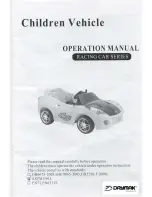
8
9
WING ASSEMBLY
❏
It is time to join the wings. Epoxy the fuse-
lage to the left wing. Make sure you keep the
area where the engine pod inserts clear of glue,
otherwise the engine pod won’t slip into place.
❏
After the glue has set, test fit the right wing
panel. Make sure the cables thread properly
into the right wing. When satisfied, apply epoxy
to the dihedral brace and the fuselage and join
the right wing panel in place. Of course, you
have to thread the cables through the root rib.
Once again, make sure the slot for the power
pod remains clear of glue.
❏
Some white covering material is provided to
iron over the joint on the top of the wing.
❏
The two wing tiplets are attached with two
screws. You will have to drill holes for the
screws in both the tiplets and the wing tips.
❏
If you use the optional engine pod, mount the
engine on the right side of the pod with the fur-
nished hardware. Plumb the tank and mount it
with a rubber band on the left side of the pod.
❏
If you have a three or more channel radio and
an engine with a throttle, you can mount a servo
to the pod on the right side opposite the tank.
Snake the cable down the pod and around the
rear of the wing into the receiver area.
❏
The pod is slid into the slot provided and
secured with two bolts/blind nuts.
❏
A tow hook is provided to install in the
recessed area in the bottom of the fuselage.
Drill a pilot hole before screwing it in.
❏
Apply the peel and stick decals by trimming
close to the design and putting them where
desired. Refer to the box art for suggested loca-
tion. For the larger designs, spray the area with
window cleaner first, then squeegee out the
excess with the edge of a credit card.
CENTER OF GRAVITY/
BALANCE POINT
Before flight, check for the proper balance.
The V-Bat should balance on the rearmost edge
of the servo hatch cutout; or, 8-3/4” back from
the leading edge point. Add lead ballast as
needed.
You should set-up your mixer so the ratio of
elevator control is about 40% less that aileron
control. Otherwise, the V-Bat will be too pitch
sensitive. Following are the approximate throws
you should start with. They are measured at the
rear edge of the elevons.
You will find that the V-Bat is very fast, sta-
ble, and maneuverable. The glide ratio without
the engine pod is incredible due to its light
weight and efficient airfoil. On a high start or
winch it will climb like a rocket and settle down
quickly to assume a thermal search pattern. On
the slope, it will keep up with the best of them.
Actually, the V-Bat is a highly competitive slope
racer!
If you are flying with the power pod and with-
out a throttle, make your first flights with only
1/4th tank of fuel. Give yourself a chance to get
used to the plane before committing to a full
tank. A GP10 runs for quite awhile on 2-1/2
ounces!
Thank you for choosing Thunder Tiger. We
welcome your comments.
Full Right Aileron Deflection:
Right elevon moves 1/2” up
Left elevon moves 1/2” down
Full Left Aileron Deflection:
Right elevon moves 1/2” down
Left elevon moves 1/2” up
Full Up Elevator Deflection:
Both elevons move 5/16” up
Full Down Elevator Deflection:
Both elevons move 5/16” down
FLIGHT
























